

When time is of the essence it’s tempting to resort to mass campaigns to your whole contact list. But an email segmentation strategy will get you more impact by helping you send the right message to the right people. This guide explains how you can use list segmentation for more targeted email marketing campaigns, including ideas for how different businesses might divide their contacts.
We’ve all been there. A promotional email pops up in your inbox and your first thought: Why have I been sent this? Maybe it’s an invite to an event in a city you’ve never been to. Or a sale on baby items when you’re in your early twenties and not even considering kids.
Most likely the email will go straight into trash and you’ll probably unsubscribe too.
We as consumers don’t want to feel like we’re being blindly marketed to. We respond to messages that resonate with us and our unique needs.
However, that’s not to say you should be emailing each of your contacts individually. By segmenting your lists into smaller groups with shared characteristics you can send more relevant email campaigns at scale.
Below you’ll see what email segmentation looks like in practice and learn how your business can reap the benefits.
Table of Contents
Email Segmentation Basics
The concept of email list segmentation comes from the more general term, “market segmentation” — dividing a target audience into logical sub-groups based on defined criteria. In email marketing the idea is the same except your starting point is your email contact list rather than your audience as a whole.
What is email segmentation?
Email segmentation is the process of separating contact lists into smaller sections according to shared characteristics. Marketers can then target different segments with tailored email campaigns based on what they know about subscribers.
There are four types of segmentation:
- Demographic: using concrete information about who contacts are
- Psychographic: using subjective characteristics of contacts’ personalities
- Behavioral: based on contacts’ past interactions with your business
- Geographic: based on where contacts are located
Later on you’ll find examples of each of these in practice. The video below also offers an introduction to segmentation and how it works in email marketing.
Segmentation vs. personalization
A common misunderstanding when it comes to defining email segmentation is thinking that the term is interchangeable with personalization. After all, both are strategies for creating tailored emails using information collected about subscribers. However they differ in the way they achieve this.
Segmentation uses a shared trait among a group of contacts, while personalization customizes content for each individual contact. For example, using segmentation you might target everyone who has bought an item with an email promoting other relevant products. However you could personalize this campaign on an individual level by using each contact’s purchase history to share recommendations unique to them.
Of the two strategies, segmentation is your best starting point. The process will help you better understand your audience and the factors influencing customers’ behavior. You can then use this learning to identify which personalization strategies will have the greatest impact for your business.
Why is Email Segmentation Important?
The need for list segmentation comes from the fact that your audience is not a uniform group. Instead it’s made up of different types of customers whose motivations vary based on their profile. So, if you want to get the most out of each one of them, a one-size-fits-all approach isn’t going to cut it.
Segmentation enables you to target different groups with email content that is relevant to them and their needs. This comes with a host of benefits for your email marketing strategy.
Better campaign results
More relevant emails means a better response from subscribers. If your email subject line catches their interest they’ll be more likely to open it. And if the content does the same they’ll continue to do so in the future. You’ll also get more click-throughs and conversions if what you’re sending fits the reader’s needs.
On the flip side, a blanket email campaign can never satisfy everyone on your list. And if contacts regularly receive emails that don’t interest them, not only will engagement be lower but you risk a higher unsubscribe rate.
Improved deliverability
How your email campaigns perform directly impacts your sender reputation. This means poor engagement from a lack of segmentation could cause future campaigns to end up in spam.
By targeting contacts where your campaign will have most impact, you’ll avoid harming your performance statistics and in turn your future deliverability.
Stronger relationships
You can’t connect with individual subscribers through generic email campaigns. To sustain their interest, the recipient needs to feel like your message is written for them.
By consistently sending content that speaks to your audience on a personal level, you’ll build trust in your brand. And this translates into more loyal customers and repeat purchases.
Increased knowledge of your audience
The process of segmenting your campaigns helps deepen your understanding of your audience. For example, you can test which content works for different profiles and identify groups with the best engagement to determine your most valuable customers.
Email Segmentation Strategies
As I’ve already touched on, the possibilities for categorizing your contacts go beyond basic demographic information. Below you’ll find examples of the different types of email segmentation.


Demographic data
Segmenting by demographics is a common place to start since it’s based on more concrete information.
Demographic segmentation factors include:
- Age
- Gender identity
- Life stage and family status
- Income
Psychographic characteristics
Psychographic segmentation goes a step further than demographics as you consider not just who a contact is but the psychological factors motivating consumer behavior.
These may include:
- Interests
- Lifestyle
- Values
Contact behavior
The actions contacts take (or don’t take) also offer clues about their interest in your company’s offer.
Here are some activities to track for segmentation:
- Email engagement metrics like open rates and clicks
- Interactions with your website
- Purchase history
- Use of your product or service
Geographic factors
This is a key segmentation strategy for stores with multiple locations or businesses with an international audience.
You might group contacts by:
- Country, region, town, or zip code
- Time zone
- Language
11 Email Segmentation Ideas for Every Business
As you’ve seen above, there are endless variables you could use to divide up your email list. The key is to find the ones that have the most impact on how people interact with your business.
To get you started, this list has use cases for how you might tailor your emails for different groups. They include:
Segmenting by email activity
1. Subscriber engagement
How often contacts are clicking and opening your emails gives you an idea of their current interest in your brand. By tailoring your communications accordingly you can capitalize on those showing most promise and avoid disengaged contacts dropping off completely.
Consider ways those with high engagement could aid your brand. For example, you could add a CTA to forward your email to a friend or ask them to fill out a survey to help you better understand your audience.
Disengaged contacts, on the other hand, will need some extra attention if you want to regain their interest. For ideas on how to do this, check out our guide on reactivation email campaigns.
2. Device
If your campaign reporting tells you what device subscribers are opening your emails on, you can use this data to improve their experience. To do so, divide your audience into those that favor mobile and those that tend to use desktop. Then send them different email designs optimized for their preferred device.
For example, you could make the following adjustments for mobile users:
- A shorter subject line
- Less text
- Buttons rather than text hyperlinks
- Single rather than multi-column layouts
3. Send time preference
Subscribers will not only differ in how they interact with your emails but also when they are most likely to do so. To maximize engagement, you can segment campaigns to stagger send times for different groups. This is particularly relevant for global audiences based across different time zones.
Another factor to consider is how often you email subscribers. Ask them for their desired frequency via preference forms then use segmentation to exclude those who want to hear from you less often from certain campaigns.
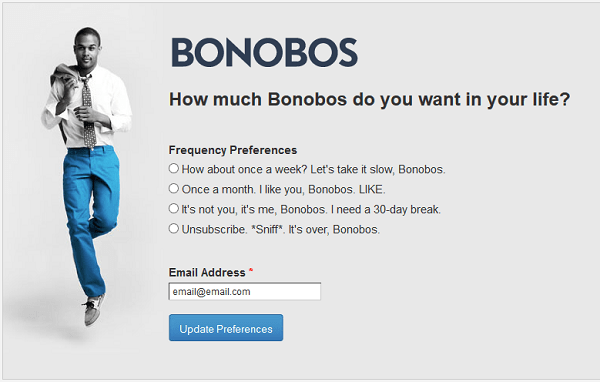

B2C segmentation ideas
4. Location
If you have multiple stores or sell to an international audience you should avoid sending mass campaigns that only apply to those in certain locations.
In the case of brick-and-mortar businesses, when an event or promotion is store specific, restrict your campaign to those within a set radius. And even if you’re selling online, you should consider whether your offer is right for a geographic region. For example, differing seasons and climates might affect which products you choose to promote.
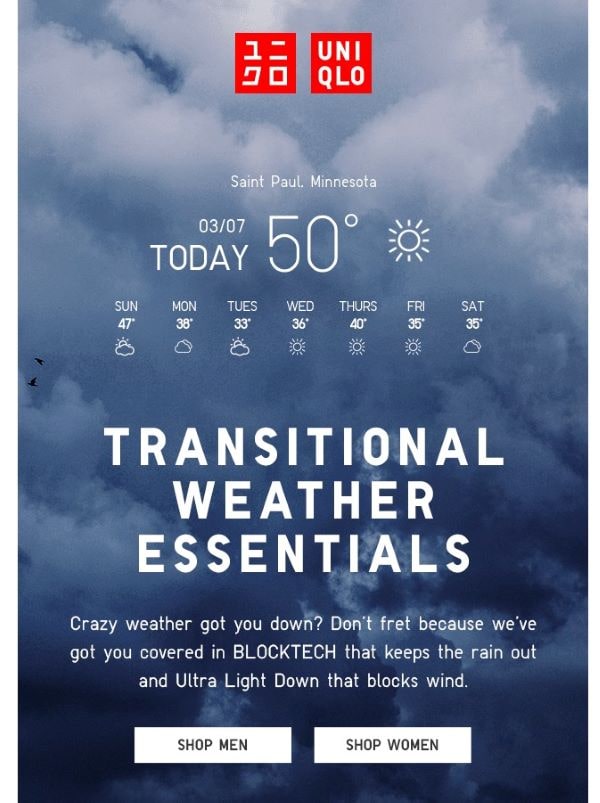
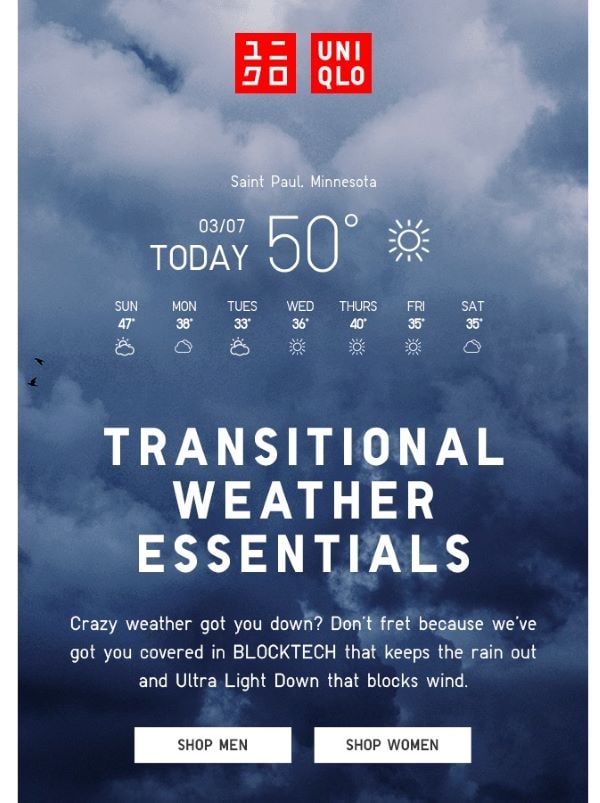
5. Product interest
Not everything you sell will be relevant to everyone on your email list. So rather than sending blanket promotions, target smaller segments of people likely to be interested in similar products with suitable offers.
You could determine interest based on:
- Demographic data: certain products may be aimed at a specific age group or gender for example.
- Explicit preferences: you could ask subscribers which products they want to hear about through a survey or when they first subscribe.
- Customer activity: ecommerce stores can track which products users view or buy.
Some customers will get as far as adding an item to their online shopping cart but fail to go through with the purchase. You can target these shoppers with a cart abandonment email that aims to reignite their interest and push them to buy.
Post-purchase emails are another opportunity to boost sales through segmentation. Based on what customers bought, you can use cross-selling to suggest other items often bought together.
6. Purchase history
Aside from giving you an idea of what a customer likes, past purchases also offer insight into their shopping habits. By identifying patterns in this you can create campaigns that will encourage them to keep buying from you.
Look into not only what customers buy but also how much they spend. That way you can promote products that fit their budget. For the most price-sensitive who normally buy items on sale, offer discount coupons to secure sales.
If you know customers buy certain items regularly you could set up reminder emails to this group prompting them to buy again after the appropriate period of time. This works well for products like cosmetics that run out at regular intervals.
7. Type of customer
Someone who has only just discovered your brand will need different content to a customer who has been with you for years. To keep all customers engaged, you should tailor campaigns to the stage they are in their journey.
Some categories for customers include:
- New subscribers who are yet to buy
You don’t want to turn off these prospects with a mistimed promotional message. Instead craft a series of welcome emails that introduce them to your brand and feed their interest through inspirational content.
- First-time customers
Once a contact converts your aim is to keep building their trust. You could do this through testimonials that expose them to more of your offering or educational resources that help them get the most out of their purchase.
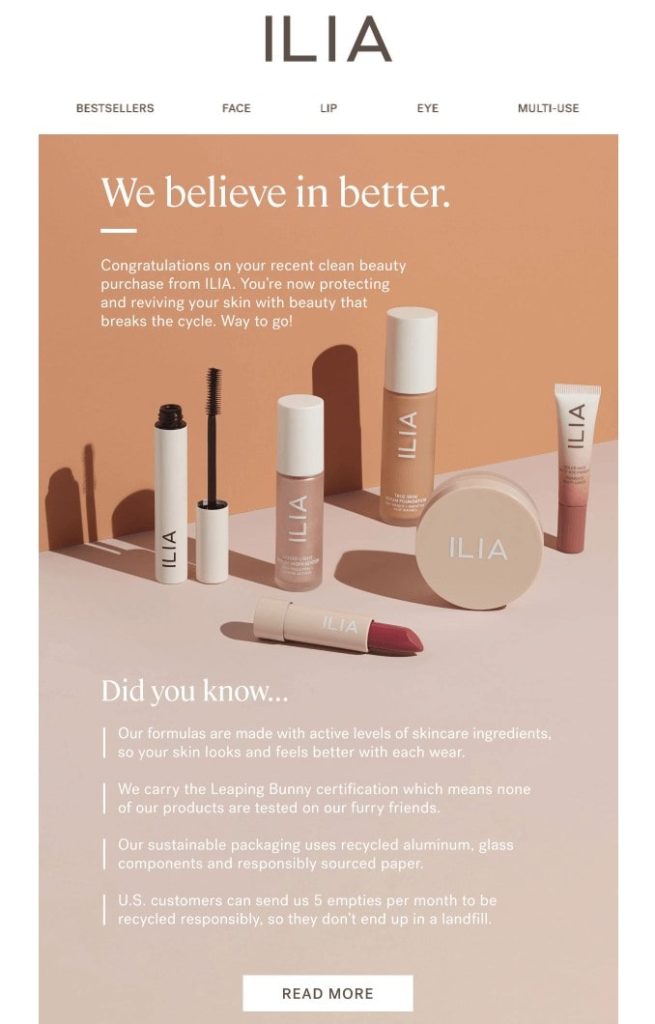

- Loyal customers
By acknowledging long-term, regular customers you can get even more value from them. Make them feel special with VIP offers like early access to new products. You can also capitalize on their loyalty by requesting a review or inviting them to refer a friend in exchange for a reward.
- Lapsed customers
For customers that have gone quiet since their last purchase, a discount offer that fits their interests can be an effective incentive to lure them back.
B2B segmentation ideas
8. Company profile
Just as B2C businesses can use demographic data to group customers, in a B2B context you can categorize companies in your audience by shared traits that impact what they’re looking for from your brand. For example, the size of a company will influence their needs and budget.
You can also tailor emails with industry-specific content based on the sector companies work in. This way you can highlight how your offer addresses their unique pain points.
9. Stage in sales funnel
By segmenting your campaigns based on where a contact is in their journey to becoming a customer, you can help ensure they move to the next stage.
For newly acquired leads who are still in the phase of discovering your brand, you need to build trust before directly promoting your offer. You can do this through high-value, educational content that showcases your expertise. As contacts show signs of interest by interacting with your content, add more product-focused information such as case studies. If engagement continues, you’re ready to push them towards conversion, for example with a demo or free trial offer.
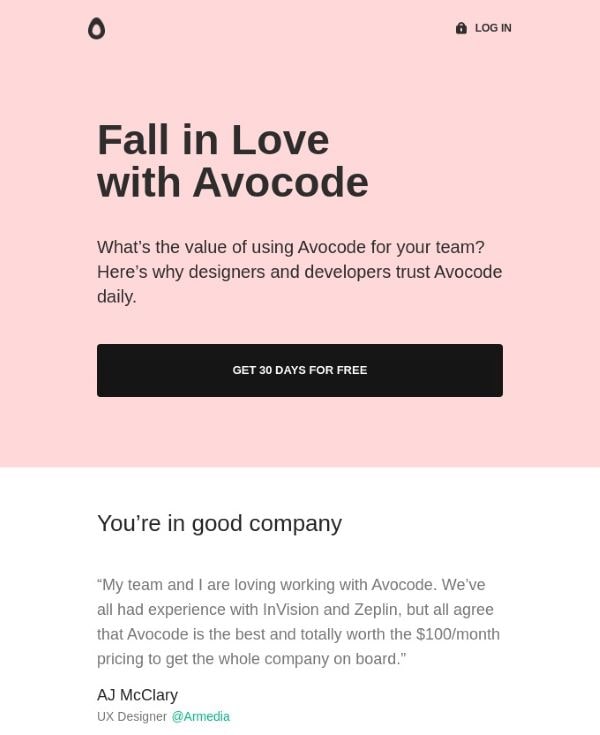
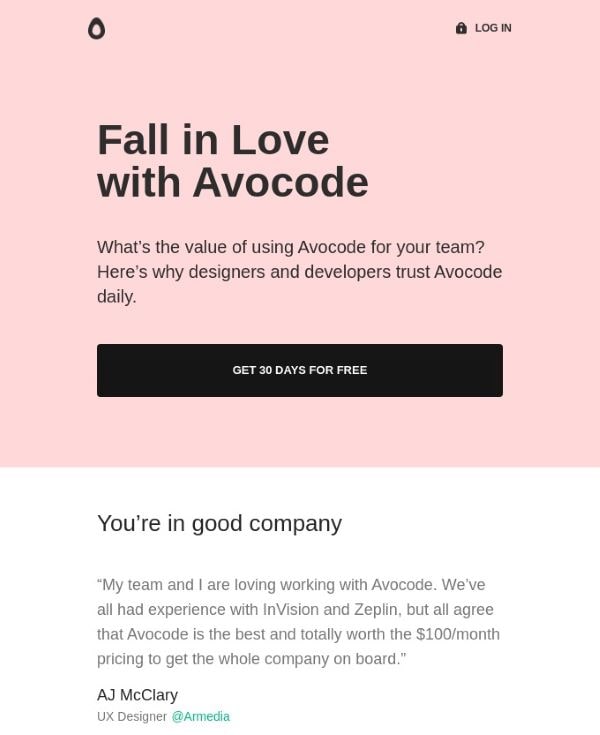
To help you track engagement levels and determine which segment contacts should fall into you can set up a lead scoring model. This involves assigning points to contacts based on their conversion potential.
There are more opportunities to nurture customer relationships through targeted campaigns post conversion too. To prevent new customers from dropping off you can create onboarding emails that walk them through getting started with your product or service. For those who’ve been with you longer, you might send dedicated campaigns to upsell additional services or prompt clients to renew their contract.
10. Acquisition source
When targeting new leads you can make your email segments even more precise by also taking into account how they discovered your brand. With this information you can continue to feed them content that is most likely to keep them engaged.
For example, if you’re using lead magnets like eBooks or webinars to attract subscribers you could focus future emails around the topic that first caught their interest.
11. Customer engagement
When it comes to existing clients, you should separate those who are most valuable from those who need some encouragement.
You might base this on how engaged customers are with your product. At one end of the scale are committed clients with a high level of usage. To keep them loyal, find ways to acknowledge them like offering beta access to new features or invites to exclusive events. On the other hand, inactive users might need extra support in the form of educational content on using your product.
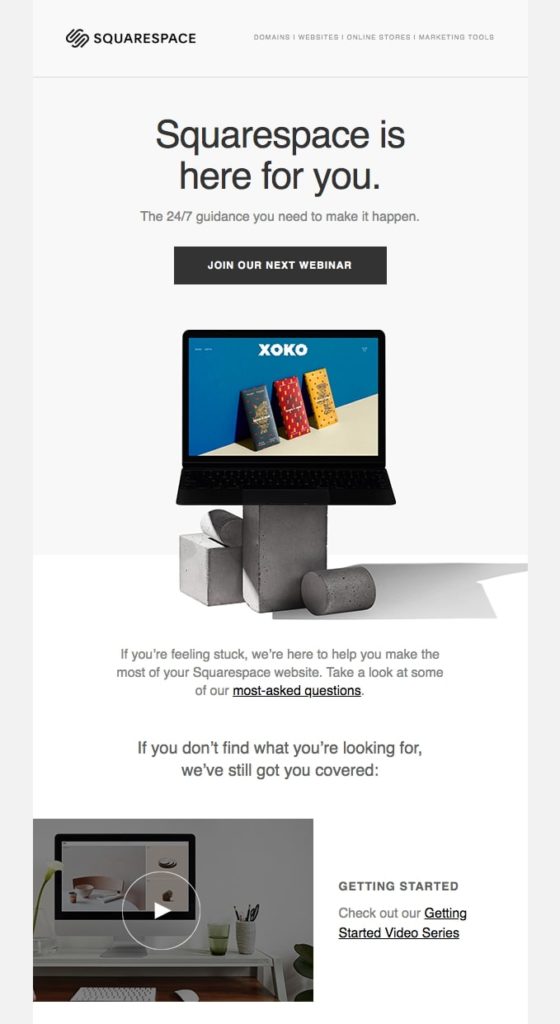

How to Segment Your Email List
Now you have some ideas of email segments to try, it’s time to put them into practice. The steps below will take you through the process.
Determine criteria for segments
Before you jump straight into dividing up your contacts, you need to be clear on exactly what will qualify someone for a certain segment. In some cases this will be obvious, such as if a contact fits a certain demographic. But for more subjective categories like whether or not a customer should be seen as loyal, you’ll need to define your own criteria.
Collect your data
Once you’ve decided on your segments, the next step is to gather the necessary information about contacts to be able to categorize them.
Your method will depend on the type of data you need. Sometimes you can ask subscribers directly via your signup form or surveys. However for behavioral data you’ll need tracking in place. For example, Sendinblue stores data on how subscribers have interacted with your emails and you can even set up tracking for website activity too.
Set up your email segmentation
Which software you’re using will determine how you go about segmenting your contacts. The main email marketing services all have tools for list segmentation but their capabilities vary.
Sendinblue allows you to create segments that are as simple or as complex as you need them to be. You have the option to add multiple conditions and use custom contact attributes to segment by whatever criteria you choose.
Build more targeted campaigns with SendinblueUse Sendinblue’s powerful segmentation tools for free with unlimited contact storage. |
Creating segments using the Sendinblue search filter
With Sendinblue, you can create segments from your lists by filtering contacts using conditions of your choice.
Here are the steps to do this:
1. In your Sendinblue account, go to “Contacts” and click the “Advanced Search & Segmentation” button.


2. Select the criteria for filtering contacts using the drop-down options and text box. For example, below is a filter to identify contacts added within the last week.


3. Use the “+” symbol to add more conditions. If you also want to include contacts that meet a separate criteria, click “Add an OR condition”. For example, the filter below will give you both the contacts who have opened at least one of your campaigns and those who have previously clicked on them.


4. Once you’ve added all your criteria, click “Save filter” to create the segment. You’ll then be able to use it as an audience for campaigns.
To see list segmentation in action on the Sendinblue platform, check out the video tutorial below.
Segmenting contacts in automation workflows
Another way of sending campaigns to more targeted groups is through email automation. With Sendinblue you can create workflows that will only send contacts emails when they meet your set criteria.
Possible triggers for adding contacts to a workflow include:
- Interactions with your emails
- Actions on your website
- Form submissions
Email list segmentation best practices
Now you know the basics on how to get started with email segmentation, here are some tips for achieving the best results:
- Keep it simple
Don’t create endless segments for the sake of it. Instead identify the most important factors influencing your customers’ decisions to direct your strategy.
- Understand your audience
Do some research to build a picture of your buyer personas — that is what your ideal customers look like. Then you can create relevant segments around their main characteristics.
- Don’t ask subscribers for too much
While subscription forms are a useful source for collecting contact data, you need to be careful not to deter people from signing up at all. Make it clear why you’re asking for the information and what the benefit will be for them.
- Combine conditions for more precise segments
Using multiple criteria for segments will help you create campaigns that feel even more personalized. For example, rather than just targeting those who identify as women you could narrow this down further to those who have also bought a certain type of product.
- Save time with dynamic content
If you only want to change certain parts of your emails for different groups, you can avoid having to create separate campaigns by using dynamic blocks. These will only appear to contacts that match your set criteria.
- Monitor performance
Once you’ve set up your segmented campaigns keep an eye on their results. That way you’ll gain insights into what works for different audiences to inform your content going forward.
See How Segmented Campaigns Can Boost Your Results
Now you have the know-how, it’s time to move away from mass emails towards more personalized experiences for your subscribers.
Start small by identifying one key variable that sets apart sections of your audience. From there you can adjust your campaigns to address their different needs. Even minor changes to your emails can mean they’ll resonate better with recipients, leading to higher engagement and more conversions.
If you need a tool to easily divide up your contacts, give Sendinblue a try. You’ll get full access to segmentation features on the free plan, which includes unlimited contact storage and up to 300 email sends per day.
 Deutsch
Deutsch





















Comments
There’s definitely going to be a huge increasement of engagement from more personalized content!
There’s a big difference from a personal email approach and just by sending email blast. Your list will know and will feel your approach if its personal. That will give you better results and its proven as long as you made a good content to your blast and proper segmentation.
Couldn’t agree more Chris!
On point and I hope this post can reach more new or to those who are seeking more tips on getting better results. If you are going to ask me, I would say connection and understanding your list are the one big factor on getting good conversion.
You’re absolutely right Sophia — you can’t sell to an audience that you know nothing about. It’s essential that you get to know your customers’ (and prospects’) needs and pain points if you really want to strike a chord.
People should understand the importance of segmentation as it is like cleaning your own house. It will help you understand and plan on your approach on your next email. I just shared this to my fb wall! Cheers!
I couldn’t agree more Kyle! Thanks for sharing the post!
I had a great time reading your piece of writing. Kudos to your blog!! Looking forward to more such blogs!
Ready to find your marketing zen?
Take the stress out of your work day with a solution that’s built for you!
Get started free